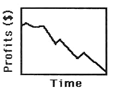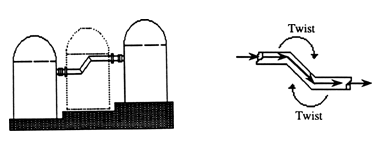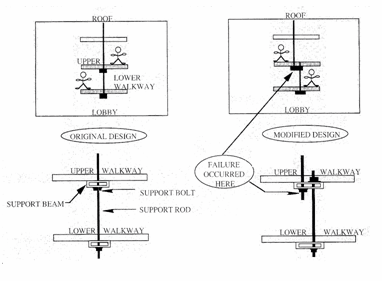Professional Reference Shelf
Topics
- Defining the Real Problem
- Correct Problem, Wrong Solution
| 1. Defining the Real Problem |
top
|
One of the greatest challenges when solving real-world problems is making sure that the real problem is defined instead of the perceived problem.
Problem definition is a common but difficult task because true problems are often disguised in a variety of ways.
The following examples present a series of real-life situations from case histories showing how easy it is to fall into the trap of defining and solving the wrong problem.
In these examples and the discussions that follow, the perceived problem refers to a problem that is thought to be correctly defined but that actually is not.
These examples provide evidence of how millions of dollars and thousands of hours can be wasted as a consequence of poor problem definition and solution.
| The situation: A local merchant on Main Street in Ann Arbor was having difficulty selling a health food mix from the rain forest called Rain Forest Crunch, which was a hot selling item in other stores. Part of the attractiveness of Rain Forest Crunch was that it was indeed from the Brazilian rainforest and part of the proceeds of the sale went to protect the rain forest. The instructions given by the store manager: "Lower the price of the item to increase sales." Rain Forest Crunch still did not sell. The manager lowered the price further. Still no sales. After lowering the price two more times to a level that was well below the competitors', the item still did not sell. Finally, the manager walked around the store, and studied the display of Rain Forest Crunch. Then the real problem was uncovered. The problem was not the high cost of the item; the real problem was that it was not in a prominent position in the store to be easily seen by the customers. Once the item was made more visible, sales began to soar. |
 |
Courtesy of Margaret Michael, University of Michigan
 |
The Situation: In the 1980's, a government-operated factory in a developing country was taking material from a refinery and using it to make fertilizer. When the plant was designed and built, the price of the fertilizer was quite high and large profits were expected to be made. Unfortunately, shortly after the plant was in operation, the price of fertilizer dropped, and as a result the plant was operating at a loss. The instructions given by the government to solve the perceived problem: "Close the plant because the price of the fertilizer is too low and we can no longer afford to operate it." However, student engineers investigated the situation as a class project and found the real problem was not the price of fertilizer, but the inefficiency of operation which resulted from a power failure to the plant three to four times per week. There were enormous costs associated with restarting the plant after each power failure. The plant could still have made a substantial profit if the power failures had been prevented with emergency generators. |
| 2. Correct Problem, Wrong Solution |
top
|
In this section, we discuss some examples where the real problem has been correctly defined, but the solutions to the problem were woefully inadequate, incorrect, or unnecessary.
The individuals who made the decisions in the situations described in these examples were all competent, hard-working professionals.
Unfortunately, they overlooked some essential details that might have prevented the accidents and mistakes.
On June 1, 1974, the Nypro factory in Flixborough, England was destroyed and 28 men were killed when a vapor cloud of cyclohexane (a flammable chemical) ignited. Three units in the plant, each on a different level, were connected in a series. The middle unit was not operating efficiently. The problem statement was: "Remove and repair the middle unit." What followed was a faulty solution to the correct problem statement. When the middle unit was removed for repairs, a bent makeshift replacement pipe was used to connect the first and third units. A slight rise in the pressure and flow rates between the units caused the bent pipe to twist, producing excessive strain. The pipe then ruptured, causing leakage of the vapor, which subsequently ignited, resulting in the explosion. Unfortunately, the only design consideration for the temporary pipe was a chalk drawing on the plant floor. Seemingly, the ramifications of such a replacement were not thoroughly thought out and certainly no concern was given to the strain that eventually caused the leak. This example shows the danger of a quick-fix solution that was not well thought out. Using Potential Problem Analysis might have prevented this disaster.

| The Kansas City Hyatt |
top
|
The newly constructed Kansas City Hyatt Regency Hotel opened in 1980. It had three skywalks connecting the bedroom areas with the conference areas on all three levels. The skywalks were 120 feet long and were suspended from the roof. On July 17, 1981, a tea dance was being held in the lobby area, and people were watching from the skywalks and from the lobby below. The lower two skywalks collapsed, plummeting to the lobby below. Over 70 tons of concrete and girders fell to the ground. There were 114 people killed and hundreds more injured. It did not take long to determine the cause of the accident. In the original design, the top walkway was to be hung from the ceiling by long rods that passed through it and also supported the lower walkway. In this version of the design, each bolt had to support only one walkway. But somewhere between the original design and the actual construction, it was decided to replace each single long rod by two shorter rods. As a result, the bolt under the top walkway had to support not only the upper walkway, but the lower one as well, which doubled the force on the upper bolt. The connection failed when the bolt pulled through the upper walkway, and as a result, both walkways fell. A Potential Problem Analysis (PPA) on the modified design may have prevented the change from being implemented.

| London Underground: Extending the Subway |
top
|
As more and more people began commuting in their cars to downtown London the motorways
became jammed and the commute took longer and longer. To solve this problem the London
Transportation Authority made the correct decision to extend the Jubilee Line of the
underground out to the suburbs.
At the same time the project was initiated, new trains were ordered for this expanded
service. The tunnels were dug, the track laid, the underground stations completed and
the new trains were brought in to be placed on the tracks. After this placement was
tried the following headline appeared in the Evening Standard Newspaper in London.
If a Potential Problem Analysis (see Chapter 8) had been carried out, this terrible
situation most likely could have been avoided.
Flow meters, such as the ones used at gasoline pumps to measure the number of gallons of gas delivered to your gas tank, are commonplace in industry.
A flow meter was installed in a chemical plant to measure the flow rate of a corrosive fluid. A few months after its installation, the corrosive fluid ate through the flow meter and began to leak onto the plant floor.
The following instruction was given to solve the perceived problem: "Find material from which to make a flow meter that will not corrode and cause leakage of the dangerous fluid."
An extensive, time-consuming search was carried out to find such a material and a company that would construct a cost-effective flow meter. None was found.
The real problem statement should have been "Prevent the flow meter from leaking."
The solution was to institute a program in which workers simply replaced the existing flow meter on a regular basis before corrosion caused a failure.






